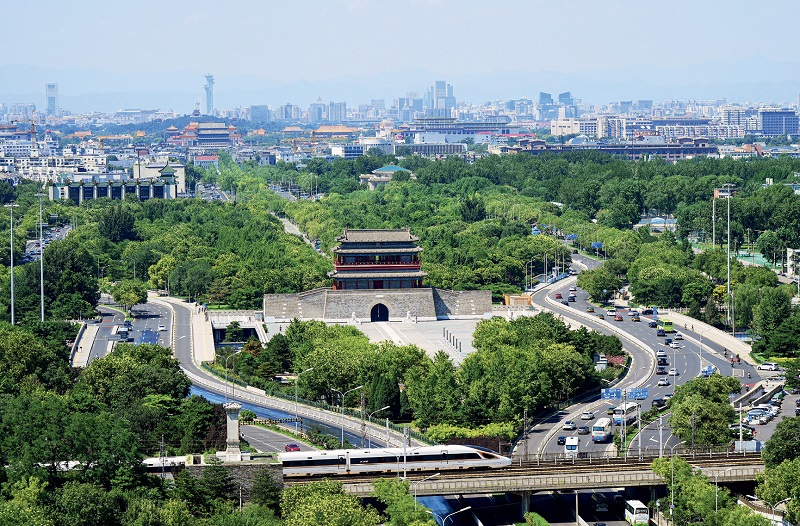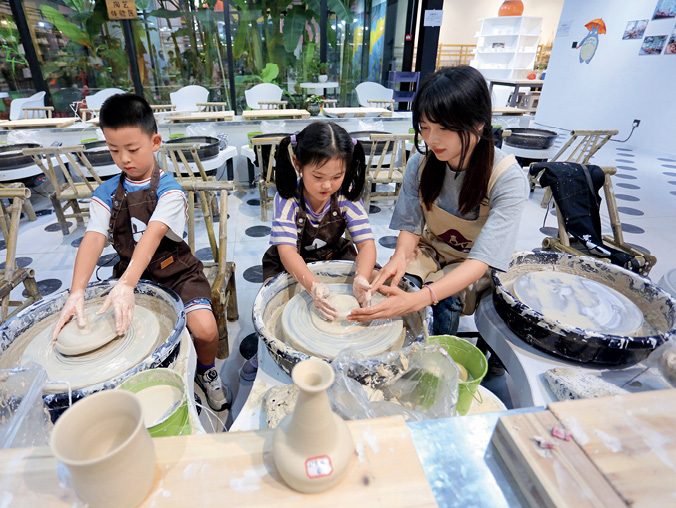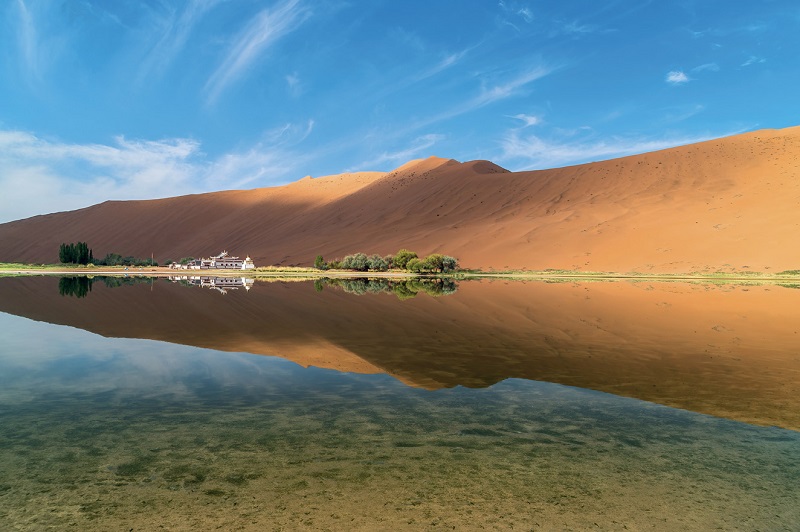China stresses the importance of protecting, utilizing and conducting international cooperation on cultural heritage.
The 46th session of the UNESCO World Heritage Committee held in New Delhi, India, in July, decided to put three more Chinese legacies on its World Heritage List, taking the total number of Chinese World Heritage Sites to 59. The three new entrants were the Beijing Central Axis, a cultural heritage, and the Badain Jaran Desert in north China as well as the Migratory Bird Sanctuaries along the coast of the Yellow Sea-Bohai Gulf (phase II), two natural heritages.
President Xi Jinping applauded the decision, saying the inclusion “has positive significance for the building of Chinese modernization that features material and cultural-ethical advancement and harmony between humanity and nature.” To make ancient cultural heritages shine brighter, they must be protected, utilized, and be involved in cooperation.

A bullet train operating on the Beijing-Tianjin Intercity Railway passes by the Yongdingmen Gate, a landmark building on Beijing’s Central Axis on July 17, 2024.
Protecting the Past
The Beijing Central Axis, an imaginary line that however is the foundation of the capital’s planning, stretches 7.8 kilometers from the Drum and Bell Towers in the north to the Yongdingmen Gate in the south. A unique symbol of Chinese civilization, it runs through the key edifices in the city, from time-honored imperial palaces and gardens to ceremonial and public buildings.
Shan Jixiang, director of the Palace Museum Research Institute and president of the China Cultural Relics Academy, spoke about the significance of the Central Axis in an earlier article in China Today, saying, “The Central Axis embodies the city order and planning ideas from the Zhou Dynasty (1046-256 B.C.). It is also the core of urban composition and the backbone of the urban pattern. The streets and hutongs (alleyways) on both sides of the axis maintain a unique pattern, so that the entire old city forms a large area of symmetry, creating a sense of unique grandeur. In this way, the open urban space can be controlled, so that the city has a strong sense of wholeness, stability, and belonging.”
Given the significance of cultural heritage, protecting them helps the following generations better understand their cultural roots. Xi has stressed the significance of protecting cultural heritage many times. During his inspection tour of Beijing in 2014, he said, “We must protect a city’s historical and cultural heritage as we cherish our own lives.” In May 2020, while touring Shanxi Province in north China, he said, “Historical and cultural heritage is an invaluable resource that is non-renewable and irreplaceable; therefore, protection must always be the top priority.”
The recognition of the Beijing Central Axis as a World Heritage Site itself is a process of protection. In October 2022, The Regulations on the Conservation of Beijing Central Axis Cultural Heritage were enacted. It was the first local legislation in Beijing formulated to protect specific cultural heritage. In January 2023, The Protection Management Plan for Beijing Central Axis (2022-2035) was released, outlining the strategy for conservation efforts.
Efforts are ongoing to vacate and renovate occupied cultural heritage sites and protect historical buildings along the route. Many areas in the Temple of Agriculture in Beijing, where emperors of the Ming and Qing dynasties (1368-1911) offered sacrifices to the Heaven for a bountiful harvest, were being used by various organizations as their offices. In 2018, the municipal authorities started vacating and renovating the temple and carried out remedial work. Some areas in the temple were open to the public this April, attracting a large number of tourists.
Xue Jian, curator of the Beijing Ancient Architecture Museum, said the Shencang, or Divine Barn, of the Temple of Agriculture has been vacated, non-heritage buildings have been demolished and heritage structures repaired. As a result, the original appearance of the site has been restored.

A bullet train operating on the Beijing-Tianjin Intercity Railway passes by the Yongdingmen Gate, a landmark building on Beijing’s Central Axis on July 17, 2024.
Meeting People’s Needs
Protecting cultural heritage is the first step. Xi has pointed out that while prioritizing the protection of historical and cultural heritage, it should also be ensured that it is reasonably utilized so that it can play “a role in providing public cultural services and meeting the intellectual and cultural needs of the people.”
At a meeting in November 2021, he elaborated on this issue, saying: “We must strengthen the protection and utilization of cultural relics and the preservation and inheritance of cultural heritage. We should enhance the research, interpretation, and presentation of cultural relics, truly bringing them to life so that they become a profound source of nourishment for advancing socialist cultural-ethical progress and an important symbol for expanding the international influence of Chinese culture.”
Various measures have been adopted to reinvigorate cultural heritage sites around China. One example is the Yuanmingyuan (also known as the Old Summer Palace) Ruins Park, the most splendid imperial garden in China but ransacked by British and French armies in 1860. Over the past years, the park has employed digital technology to restore the original site virtually. In this way, visitors can appreciate its former glory.
Taoyangli, an area in Jingdezhen City in east China’s Jiangxi Province, used to be the center of Jingdezhen’s porcelain production, which is an intangible cultural heritage of China. It has been renovated to look the way it used to be and master porcelain makers demonstrate their unique techniques to visitors. In October 2023, Xi visited the area during his tour of Jiangxi and encouraged the artists to pass down their craft and keep innovating.

At the 46th session of the UNESCO World Heritage Committee held in New Delhi, India, China’s application of the Badain Jaran Desert - Towers of Sand and Lakes successfully passes the review and is officially added to the World Heritage List on July 26, 2024.
Championing International Exchange
Known for its openness and inclusiveness, the Chinese civilization has always respected and engaged in mutual learning with other civilizations. For example, in the Tang Dynasty (618-907), the capital Chang’an attracted envoys, merchants, and scholars across the world through the Silk Road, and became a major international metropolis where different cultures met.
With such a tradition, modern China continues to champion international exchanges on cultural heritage. One example is the Alliance for Cultural Heritage in Asia (ACHA). Initiated by China, ACHA aims to become an intergovernmental cooperation and exchange platform for implementing Asian cultural heritage activities.
In his congratulatory letter to the General Assembly of ACHA held in Xi’an, Shaanxi Province, in April 2023, Xi said, “Within the framework of the alliance, China is willing to work with all Asian countries to strengthen experience sharing on cultural heritage preservation, promote international cooperation in the cultural heritage sector, and establish a network for dialogue and cooperation among civilizations.”
During the second Council Meeting of ACHA held in Qingdao, Shandong Province, in June this year, China and Honduras signed their first cooperation agreement on cultural heritage since the establishment of diplomatic ties last year. They agreed to conduct practical cooperation in cultural relic protection, archaeological research, museum exchanges, and personnel training, and deepen cooperation in archaeological research, display, and utilization of the ancient Copan site, a key Maya civilization site in western Honduras.
Li Qun, chairperson of the ACHA Council and director of the National Cultural Heritage Administration, said that since last year, China and other Asian countries have carried out practical collaboration in exhibition of cultural artifacts, joint archaeological excavations, and heritage restoration. Progress is being made in advancing collaborative projects like the restoration of the Thatbyinnyu Temple in Myanmar, and archaeological excavations of the Nateshwar Temple Complex in Bangladesh.
Facing human-made wars and natural disasters like earthquakes, cultural heritage sites in many countries are under threat and multilateral cooperation is necessary to protect them. In August, Xi urged enhanced international exchange and cooperation in the field of cultural and natural heritage, and called for greater contribution to the Global Civilization Initiative and building of a global community of shared future.